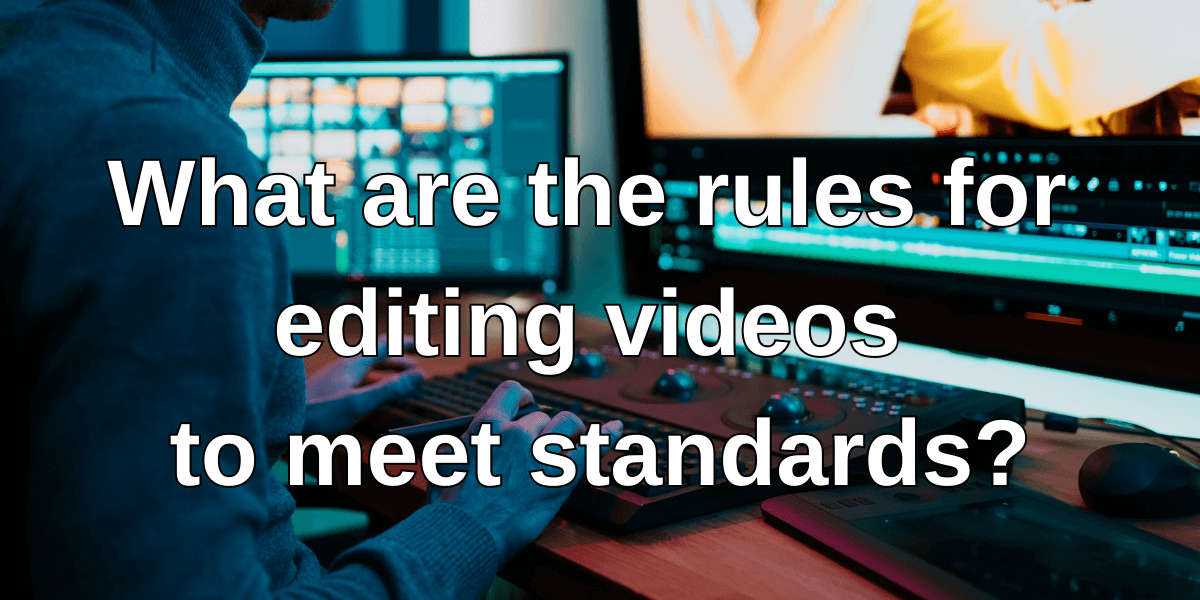Video editing is manipulating and arranging video shots to create a coherent and engaging story. Whether you are making a short film, a documentary, a tutorial, or a promotional video, you need to follow some basic rules for editing videos to meet video production standards.
These rules will help you improve your video quality, avoid common mistakes, and deliver your message effectively.
What are the rules for editing videos to meet standards?
Rule 1: Know your audience and purpose
Before you start editing your video, you need to have a clear idea of your target audience and your goal. Different types of videos require different editing styles, techniques, and formats. For example, a video for social media might be shorter, more dynamic, and more casual than a video for a professional website.
Once you know your audience, choosing between the pace, music, transitions and effects you’ll use in your videos will become easier.
A video for education might be more informative, structured, and precise than a video for entertainment. Knowing your audience and purpose will help you choose the appropriate tone, pace, length, and content for your video.
Rule 2: Follow the 180-degree rule
The 180-degree rule is a basic principle of film editing that ensures spatial continuity and clarity in your video. It states that you should keep the camera on one side of the imaginary line that connects the main subjects or objects in your scene.
This way, you avoid confusing the viewer with sudden changes in perspective, direction, or position. If you need to cross the line, you should use a cutaway, a transition, or a movement that justifies the change. The 180-degree rule applies to both single-camera and multi-camera shoots.
Rule 3: Use the rule of thirds
The rule of thirds is a simple guideline that helps you compose your shots and balance your visual elements. It divides your frame into nine equal parts by drawing two horizontal and two vertical lines. The points where the lines intersect are called the rule of thirds points.
These points are the ideal places to position your main subjects or objects, as they create more interest and tension than the center of the frame. You can also use the lines to align your horizon, your text, or your other elements. The rule of thirds can enhance your video aesthetics and storytelling.
Rule 4: Match your cuts to your audio
One of the most important aspects of video editing is matching your cuts to your audio. This means that you should synchronize your video transitions with the rhythm, mood, and flow of your sound. For example, you can cut on the beat of a music track, on a pause or a change in a dialogue, or on a sound effect that matches your action. Matching your cuts to your audio can create a smooth and seamless video that engages your viewer’s senses and emotions.
Your audio is the core of your video. People will always be willing to forgive an image that is slightly off-beat, a shaky cam, or even poor footage but they will never forgive bad audio. This includes not just your talking pieces, but every bit of audio, from your backing soundtracks to any sound effects you add to enhance your visuals.
Don’t just match your visuals to your audio, match your audio to your audio–make sure it’s at the same level of output, is well mixed, and not jarring or startling to your audience.
Rule 5: Use transitions wisely
Transitions are the effects that you use to switch from one shot to another in your video. They can help you create contrast, continuity, or connection between your scenes. However, you should use transitions wisely and sparingly, as they can also distract, confuse, or annoy your viewer if they are overused or inappropriate.
The most common and effective transitions are cuts, fades, and dissolves. These transitions are subtle and simple, and they can convey different meanings depending on the context. For example, a cut can indicate a change in time, place, or action; a fade can indicate a passage of time, a flashback, or an end; and a dissolve can indicate a connection, a similarity, or a transition.
Rule 6: Review and refine your video
The final rule for editing videos to meet video production standards is to review and refine your video before you export and share it.
You should watch your video several times, from different perspectives and devices, and look for any errors, inconsistencies, or improvements that you can make.
You should also ask for feedback from other people, preferably from your target audience or someone who knows about video editing.
You should check your video for technical quality, such as resolution, aspect ratio, frame rate, color, sound, and subtitles.
You should also check your video for creative quality, such as clarity, coherence, relevance, and impact.



